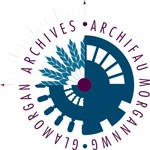The Ocean and National Magazine collection is an amazing resource for discovering what life was like for people living in the south Wales coalfield in the 1920s and 1930s. Published by the Ocean Coal Company Ltd and United National Collieries Ltd, with contributions by and for the workforce, this magazine series contains a wide variety of articles on the coal industry and its history, including industrial relations, employees, technology, culture and sporting events. Andrew Booth, one of our volunteers has recently completed the indexing of this fantastic collection. This is the third of a series of blog posts in which Andrew highlights stories from the Ocean and National Magazines.
**********

Cover of January 1930 edition, D1400/9/3/1
Many contributions to the magazine include technical and scientific articles concerning coal mining processes. One such feature appeared in 1930, with a series of articles from a party of then-current or former members of Ocean’s coal mines in south Wales, concerning the tour they made of the coalfields of north east England.

Group taken at Seghill Colliery during tour of collieries of north-east England, D1400/9/3/1, p.13
Machinery and mining techniques are discussed within the articles, with L. Phillips, Manager, Nine Mile Point Colliery, discussing, in January 1930, how machines were being used in the north of England to assist miners. He remarks that using machines in a coal mine was not as straightforward as using machines in steelworks or tinplate mills or car factories, but notes that over 22% of the total coal produced at the time was cut by machinery. He discusses the types of conveyors used to deal with the large quantity of coal cut by the coal-cutters and how perfect cooperation between officials and men is needed to ensure the efficiency of this system.

Sketch plan of face and belt truck conveyor, D1400/9/3/1, p.9
Coal mining methodology is also discussed in the February edition by Ben Phillips of Park Pit. Within his article he compares methods of working the coal seams in south Wales and the north-west of England. He discussed the board and pillar and long wall methods. He notes longwall had been introduced …as the result of the exhaustion of the thicker seams of coal in the Northern coalfields… and writes about the variations found within both methods.

Methods of working compared with South Wales, D1400/9/3/2, p.45
At Ashington Colliery, Daniel J. Thomas, Newcastle-upon-Tyne (formerly engaged in the Engineers’ department, Treorchy) comments that at Ashington Colliery his group had the pleasure of lighting a cigarette at the coalface, within 10 feet of an electrical coal cutter. Although impressed by the use of electricity at Seghill Colliery, he was disappointed when he visited the colliery, as …although electricity was solely used they did not generate any. Other collieries within the coalfield of north east England were also benefitting from the use of electricity. When Thomas’ team visited Haworth Colliery, they were able to see a pair of electric winders, capable of raising 7½ tons of coal per wind from a depth of 1000 yards.
Differences in working practices were also mentioned. In one particular article from the January edition, Daniel J. Thomas, a former Treorchy engineer based in Newcastle-upon-Tyne, comments on the strange shift times of the miners at Usworth: …some men went in at 5am and others at 11am.
Through these articles readers would have been able to gain an understanding of the technical side of mining and the similarities and differences in the working practices of the south Wales and northern England coalfields.
Andrew Booth, Glamorgan Archives Volunteer













